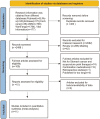Therapeutic efficacy of acupuncture point stimulation for stomach cancer pain: a systematic review and meta-analysis
- PMID: 38638316
- PMCID: PMC11024429
- DOI: 10.3389/fneur.2024.1334657
Therapeutic efficacy of acupuncture point stimulation for stomach cancer pain: a systematic review and meta-analysis
Abstract
Purpose: In recent years, traditional Chinese medicine has received widespread attention in the field of cancer pain treatment. This meta-analysis is the first to evaluate the effectiveness and safety of acupuncture point stimulation in the treatment of stomach cancer pain.
Methods: For this systematic review and meta-analysis, we searched PubMed, Web of Science, Cochrane Library, Embase, WANFANG, China National Knowledge Infrastructure (CNKI), and Chinese Journal of Science and Technology (VIP) databases as well as forward and backward citations to studies published between database creation to July 27, 2023. All randomized controlled trials (RCTs) on acupuncture point stimulation for the treatment of patients with stomach cancer pain were included without language restrictions. We assessed all outcome indicators of the included trials. The evidence from the randomized controlled trials was synthesized as the standardized mean difference (SMD) of symptom change. The quality of the evidence was assessed using the Cochrane Risk of Bias tool. This study is registered on PROSPERO under the number CRD42023457341.
Results: Eleven RCTs were included. The study included 768 patients, split into 2 groups: acupuncture point stimulation treatment group (n = 406), medication control group (n = 372). The results showed that treatment was more effective in the acupuncture point stimulation treatment group than in the medication control group (efficacy rate, RR = 1.63, 95% CI 1.37 to 1.94, p < 0.00001), decreasing in NRS score was greater in acupuncture point stimulation treatment group than in the medication control group (SMD = -1.30, 95% CI -1.96 to -0.63, p < 0.001).
Systematic review registration: https://clinicaltrials.gov/, identifier CRD42023457341.
Keywords: acupuncture point stimulation; meta-analysis; stomach cancer pain; therapeutic efficacy; traditional Chinese medicine.
Copyright © 2024 Zhou, Zhang, Jiang, Zhang, Gu, Tang, Pu, Quan, Chi and Huang.
Conflict of interest statement
The authors declare that the research was conducted in the absence of any commercial or financial relationships that could be construed as a potential conflict of interest.
Figures









Similar articles
-
Acupuncture for insomnia symptoms in hypertensive patients: a systematic review and meta-analysis.Front Neurol. 2024 Feb 19;15:1329132. doi: 10.3389/fneur.2024.1329132. eCollection 2024. Front Neurol. 2024. PMID: 38440112 Free PMC article.
-
Clinical evidence of acupuncture and moxibustion for irritable bowel syndrome: A systematic review and meta-analysis of randomized controlled trials.Front Public Health. 2022 Nov 24;10:1022145. doi: 10.3389/fpubh.2022.1022145. eCollection 2022. Front Public Health. 2022. PMID: 36589968 Free PMC article.
-
Efficacy and Safety of Acupuncture in Renal Colic Caused by Urinary Calculi in Adults: A Systematic Review and Meta-Analysis.Evid Based Complement Alternat Med. 2022 Jul 4;2022:7140038. doi: 10.1155/2022/7140038. eCollection 2022. Evid Based Complement Alternat Med. 2022. PMID: 35832526 Free PMC article. Review.
-
Combining various acupuncture therapies with multimodal analgesia to enhance postoperative pain management following total knee arthroplasty: a network meta-analysis of randomized controlled trials.Front Neurol. 2024 Mar 18;15:1361037. doi: 10.3389/fneur.2024.1361037. eCollection 2024. Front Neurol. 2024. PMID: 38562427 Free PMC article.
-
Acupuncture therapy on myofascial pain syndrome: a systematic review and meta-analysis.Front Neurol. 2024 May 3;15:1374542. doi: 10.3389/fneur.2024.1374542. eCollection 2024. Front Neurol. 2024. PMID: 38765261 Free PMC article.
Cited by
-
Auricular acupoint therapy for functional gastrointestinal disorders: a systematic review and meta-analysis of randomized clinical trials.Front Med (Lausanne). 2025 Mar 19;12:1513272. doi: 10.3389/fmed.2025.1513272. eCollection 2025. Front Med (Lausanne). 2025. PMID: 40177277 Free PMC article.
-
Effectiveness of Pulse Intravenous Infusion of Methylprednisolone on Pain in Patients with Lumbar Disc Herniation: A Randomized Controlled Trial.Anesth Pain Med. 2024 Sep 7;14(4):e149442. doi: 10.5812/aapm-149442. eCollection 2024 Aug. Anesth Pain Med. 2024. PMID: 40078470 Free PMC article.
-
Effectiveness and safety of acupuncture for cancer-related hiccups: a systematic review and meta-analysis.Front Neurol. 2024 Dec 11;15:1480656. doi: 10.3389/fneur.2024.1480656. eCollection 2024. Front Neurol. 2024. PMID: 39722696 Free PMC article.
-
Efficacy of acupuncture in experimental intracerebral hemorrhage: a systematic review and meta-analysis.Front Neurol. 2024 Jun 13;15:1402129. doi: 10.3389/fneur.2024.1402129. eCollection 2024. Front Neurol. 2024. PMID: 38938782 Free PMC article.
-
Comparison of the efficacy of cefoperazone-sulbactam and other cephalosporins in the treatment of infections: A systematic review and meta-analysis.Medicine (Baltimore). 2025 Apr 25;104(17):e42182. doi: 10.1097/MD.0000000000042182. Medicine (Baltimore). 2025. PMID: 40295277 Free PMC article.
References
-
- Money S, Garber B. Management of cancer pain. Curr Emerg Hosp Med Rep. (2018) 6:141–6.
-
- World Health Organization . WHO guidelines for the pharmacological and radiotherapeutic management of cancer pain in adults and adolescents. Available at: https://www.who.int/publications/i/item/who-guidelines-for-the-pharmacol... (2019). - PubMed
Publication types
LinkOut - more resources
Full Text Sources

